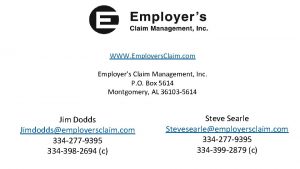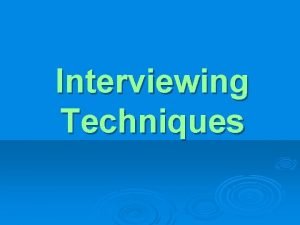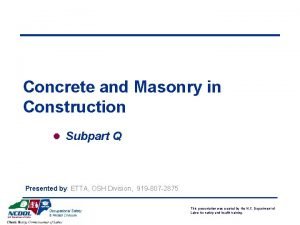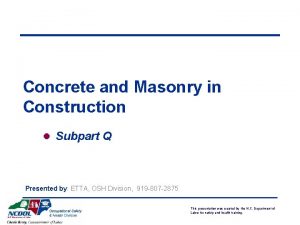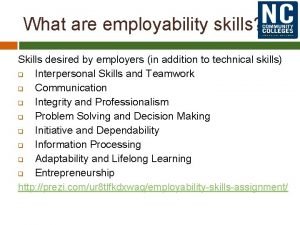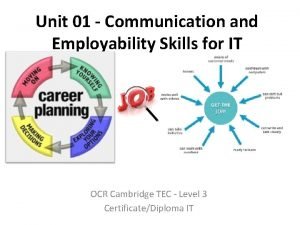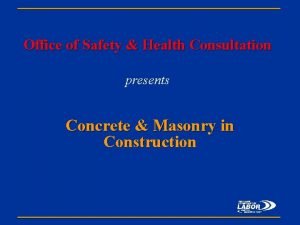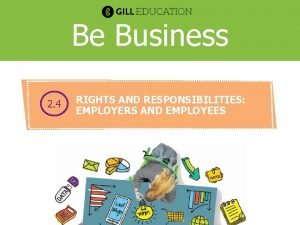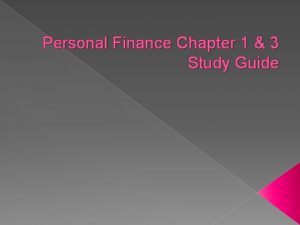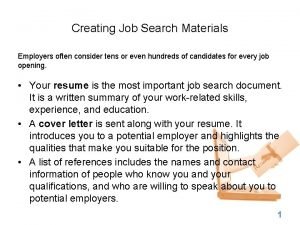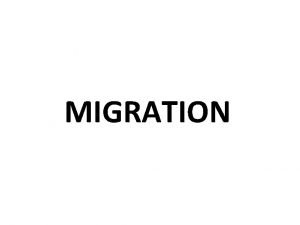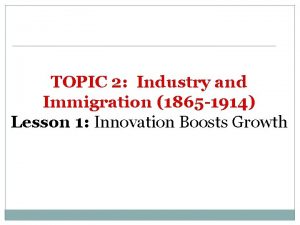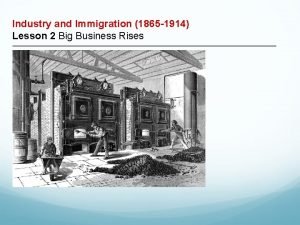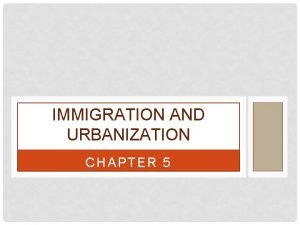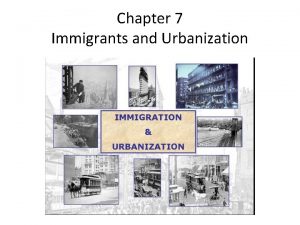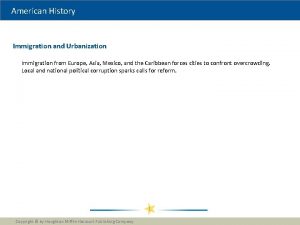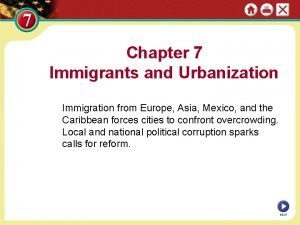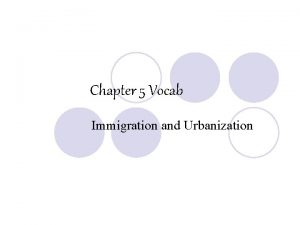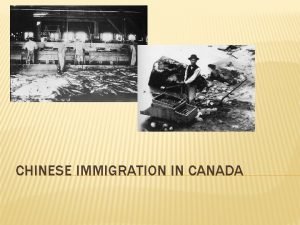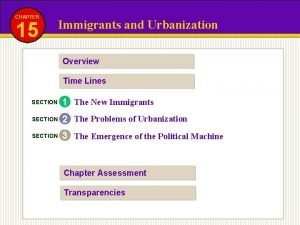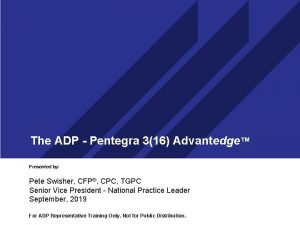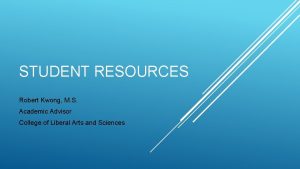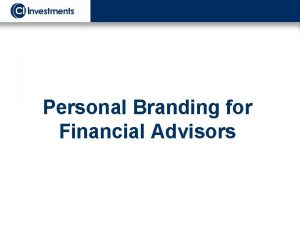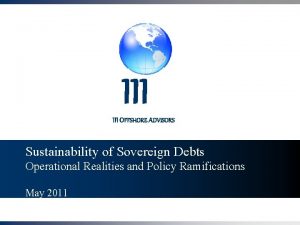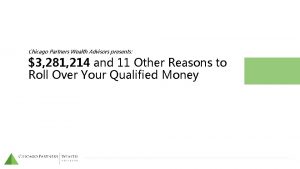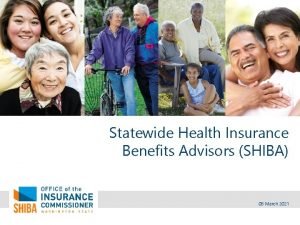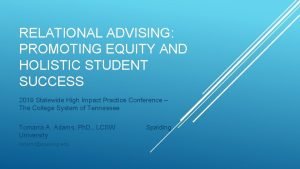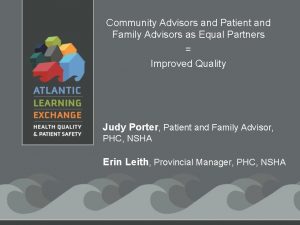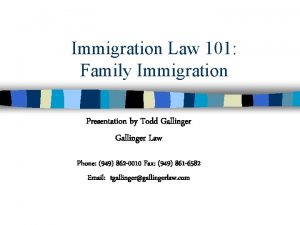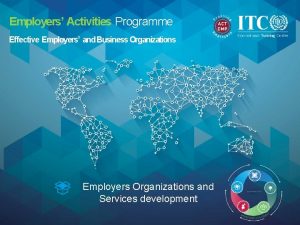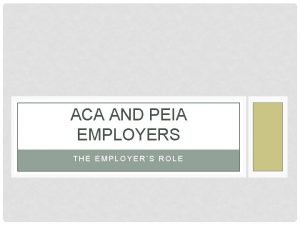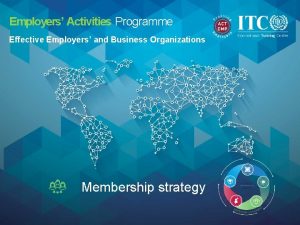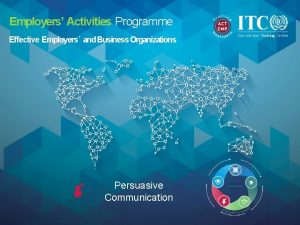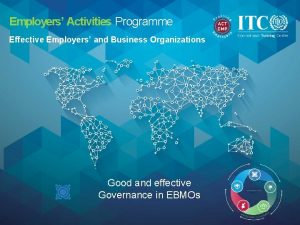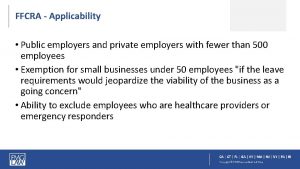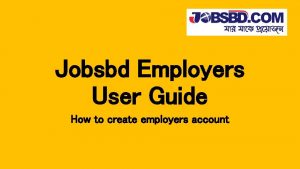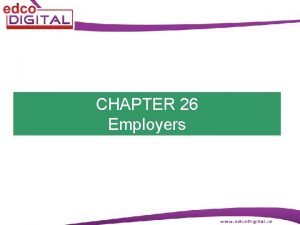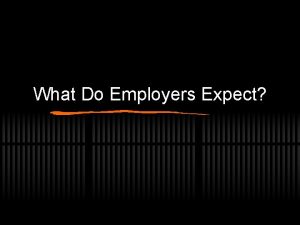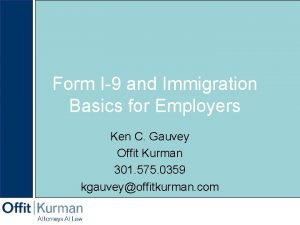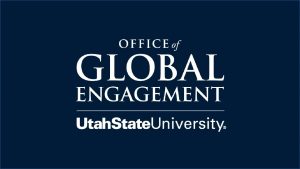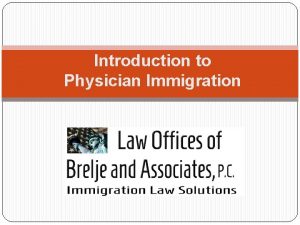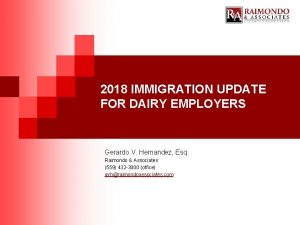Immigration 101 An introduction for employers and advisors

































- Slides: 33

Immigration 101: An introduction for employers and advisors Kathleen Gasparian Immigration 504 262 9878 kathleen@gasparianimmigration. com

Definitions Citizen: Fully admitted to our political and economic community. Immigrant: Legally come to the U. S. to live and work permanently. Non-immigrant: Come to the U. S. for specific purpose, limited period of time. Other: Live in U. S. with government permission, but are neither non-immigrants nor immigrants. Undocumented: Enter without inspection or by fraud, or stay has expired.

Ways to Come to the United States Family Employment Asylees/Refugees Visa Lottery Investment Special Programs

The traditional scenario An F-1 student begins a relationship with an Employer as an intern or in Optional Practical Training. Employer realizes that the foreign national is an amazing employee and agrees to undertake the H-1 B process. Foreign national works for a few years in H-1 B status for employer. Employer then agrees to undertake the labor certification process and sponsors the foreign national for permanent residence.

The scenarios now? Unprecedented demand for H 1 B visas coupled with the cap system. Relatively short processing times for permanent residence for individuals from all countries except India and China. Changes in STEM OPT that make 3 years of OPT possible. Very long backlogs in all but the first preference for India and China. Which means the traditional scenario might not be the best fit.

What you need to know about OPT… There are two kinds of OPT: Regular and STEM Regular OPT is one year work authorization available to almost all F-1 students at the completion of each higher degree. The student can apply for regular OPT without a job offer. Has authorization to start employment once the card is in hand. Student applies for OPT with USCIS within 90 days before or 60 days after graduation date. The card is usually good for one year. Can be for work with any employer in a position related to the field of study and commiserate to the degree. Must work 20 hours a week in paid/unpaid/ volunteer of selfemployment.

What you need to know about Regular OPT… For advisors Make sure the foreign national is working with the international office Once the student has OPT, it is very important they remain employed The day before graduation or the day before OPT runs out is not the time to be making plans. Advocate planning early (and often). Help the student be strategic about graduation dates and application dates. For employers There is no cost to you for OPT – no filing fees, no requirements for everify, no other obligations. It is only for one year. Transitioning to a work visa takes planning.

STEM OPT Allows some students with U. S. science, technology, engineering, or math degrees to apply to extend their post-completion OPT authorization for 24 months (total of 3 years) What counts as a STEM field has been expanded. Two 24 -month STEM extensions may be granted per lifetime. Can only do one STEM OPT per degree. Can use prior degree as basis for STEM extension. i. e. MBA now and bachelor degree in a STEM field can do an extension now. Can’t stack STEM OPT to get 6 consecutive years.

STEM OPT A foreign national in STEM OPT must be employed in a position related to STEM field of study. Can work with more than one employer, but each employer has to meet requirements. Part-time work is okay, but volunteer will not be sufficient. Student has reporting obligations to the DSO – including 2 self evaluations.

STEM OPT – Employer Responsibilities Be enrolled in E-Verify and remain in good standing. Report material changes to the STEM OPT student’s employment to the DSO within 5 business days. Implement a formal training program to augment the student’s academic learning through practical experience. Provide an OPT opportunity that is commensurate with those of similarly situated U. S. workers in duties, hours, and compensation. Complete the Form I-983, Training Plan for STEM OPT Students: They have enough resources and trained personnel available to appropriately train the student; The student will not replace a full-or part-time, temporary or permanent U. S. worker; and Working for the employer will help the student attain his or her training objectives

The H-1 B The “work visa” For temporary employment in a “specialty occupation” This is a job that requires, throughout the industry, at least a bachelor’s degree (or equivalent education and experience) as the entry requirement Certain kinds of jobs almost always qualify, certain jobs almost never qualify, and for many jobs USCIS must be convinced Employee must have the necessary degree—in the right field—in hand (or at least completed) when petition is filed

H-1 B basics The employer (not the foreign national) applies or petitions with USCIS for the visa/status. It is employer and position specific. Can have more than one employer at a time Position(s) can be full or part-time Generally valid for up to 6 years (+) but granted in increments of up to 3 years. Allows for intent to become a permanent resident, so getting a visa and travel are easier. Dependents/ spouse can have H 4 status. Ease of “portability” and extensions.

H-1 B Process Analyze whether H-1 B status is proper for the position and the employee Determine “prevailing wage” for job File Labor Condition Application with DOL File H-1 B petition with USCIS If employee is in the U. S. , USCIS will change status to H-1 B (no need to leave U. S. usually) Obtain proper status (H-4) for dependents Extensions, if necessary Change of Employer (“transfer”), if necessary

The Employer’s Obligations Must agree to employ the foreign national as set out in the petition: position, location, etc. Must agree to offer to pay the return transportation cost to country of nationality if H 1 B terminated before end of visa petition approval. Must be no strike or lockout (unionized jobs). Must notify other workers of terms of job (two 10 day postings or letter to union). No recruiting required. Not an employment contract. Financial disclosure to USCIS usually minimal.

H-1 B Employer Obligations May experience a routine “site visit” after approval. Must agree to pay higher of actual or prevailing wage (aka “required wage”). Actual wage: wage paid to other similarly employed and similarly qualified workers at same worksite. Prevailing wage: weighted mean or median wages for similar positions in geographic area of employment. Basically, this means that a competitive wage must be offered. There are four levels of wages and separate wage data for higher-ed and certain other employers. See: www. flcdatacenter. com

Filing Fees Current USCIS filing fees for H-1 B petitions are: $460. 00 basic filing fee (for Form I-129) (increasing to $460 in 12/2016) $500. 00 “anti-fraud fee” (not for extensions) Training fee (ACWIA) $750. 00 (employers of fewer than 25 full-time employees) or $1500. 00 (employers of 25 or more full-time employees) Higher ed. institutions, primary/secondary schools, non-profit and U. S. govt. research entities are exempt from training fee Additional $1, 225. 00 for optional “premium processing” PL 111 -230 creates 50/50 rule – certain employees will have to pay additional $2, 000 for H-1 B and $2, 500 for L-1 A

Who pays for legal and filing fees? If the employee earns more that the required wage, the employee may be able to pay some or all of the legal and filing fees (excluding the training fee). Employee cannot pay legal/filing fees if it reduces his/her wage below the required wage. Having employee pay fees that he/she should not can result in fines, assessments of back pay, and disbarment from the H 1 B petitioning process.

The problem with H 1 Bs If The big hurdle is usually timing and visa availability. Very small number of initial H-1 Bs available every fiscal year. New batch of H-1 Bs available every Oct. 1 USCIS will accept petitions 6 months in advance (April 1 to April 5) and place in a lottery. Better chances for those with US master’s degree But, on the whole many don’t make it. Exempt from cap: higher ed. institutions and related entities (including hospitals), gov’t. and nonprofit research organizations, many K-12 schools. Beware of individuals moving from cap-exempt to cap-subject positions.

Cap Gap “Cap Gap” is the gap between the end of OPT and the start of H 1 B that many students face because they start OPT in June and H-1 Bs usually unavailable until October 1 Regulations If employer files an H-1 B petition requesting change of status for you before your OPT expires, then your OPT work authorization and “D/S” (F-1 status) are extended until 10/1 The approval notice will indicate grant of a change of status effective October 1 If there’s a lottery, and your employer’s petition is not “selected, ” when OPT ends you have a 60 -day “grace period” to remain in the U. S. (can’t work during grace period)

What you need to know…. Strategy for how to address H-1 B sponsorship with potential employers is key. Strategy for graduation dates and OPT filing dates to maximize number of shots at the lottery starts early. Advocate starting the process – both the decision and petition process – early Advocate the use of qualified/ experienced immigration attorneys. Errors and typos can result in delays, denials of petitions, loss of work authorization, fines to employer, immigration problems for employee, etc.

Finding solutions to the cap File H petition before student graduates? If student has completed all requirements and just needs to walk, then can be eligible. Continue studies/postpone graduation date Alternative visa status? Apply for change of status to dependant (if married or under 21) Employer seeks affiliation with university Student finds employment with cap-exempt employer (or concurrent employment with cap-exempt employer) Consider possibility of “green card”

Other Non-Immigrant Options Country Specific Options: TN (Mexico and Canada), E-3 (Australia), H-1 B 1 (Chile and Singapore) Treaty Investor or Treaty Trader – E-2 Multinational executive/manager or specialized knowledge – L-1 A/L-1 B Religious Worker – R-1 Extraordinary Ability or Artists – O-1 H-3 trainee H-2 B seasonal / periodic J-1 options? – beware 212(e) B-1 (tourist for business)– VERY LIMITED

Other Alternatives – Permanent Residence Employment Through an employer Self petition Close Family – Spouse, Parent, Child over 21, sibling (very long wait) Asylum Military Service (MAVNI) Diversity Visa Lottery – if possible, have both you and spouse apply and increase your chances Money (Large investment) Removal Proceedings

How long does permanent residence take? Process to permanent residence can be lengthy (years), not because the processing with the government is lengthy but because the demand for immigrant visas exceeds the supply. The higher in preference, the shorter the line.

Changes to the Visa Bulletin In September DOS made big changes to the Visa Bulletin Seemed to be a coordinated effort with USCIS Both agencies had publication/information The October bulletin was the first of the “new” process Each category has two different charts of dates One chart is the same as before and termed “Date for Final Action” The second chart has earlier dates and is called the “Dates for Filing Applications” As originally published, the October bulletin had some crazy dates for “Dates for Filing”. So, a revised October bulletin was issued before October 1 with much later dates Kerfuffle, Lawsuit, Mayhem October 14, 2015 – USCIS states Beginning with the November 2015 Department of State (DOS) Visa Bulletin, if USCIS determines that there are more immigrant visas available for a fiscal year than there are known applicants for such visas, we will state on www. uscis. gov/visabulletininfo that applicants may use the Dates for Filing Visa Applications chart. Unless otherwise stated on our website, the Application Final Action Date chart will be used to determine when individuals may file their adjustment of status applications. And we will do it within one week of DOS putting out the visa bulletin



Immigration through Employment First Preference: Extraordinary ability or achievement in sciences, arts, education, business, or athletics; Outstanding professor/ researcher; Certain multinational executives/ managers Second Preference: Professionals with advanced degree; Aliens of exceptional ability; National interest waiver of job offer and labor certification for professional with advanced degree or alien of exceptional ability

Immigration through Employment Third Preference: Skilled workers - Members of the professions holding minimum of Bachelor’s degree or where job requires at least two years education, training or experience Other workers (where job requires less than two years education, training, or experience). Generally requires PERM except nurses and physical therapists

Immigration through Employment - the very simple version- Step 1 The employer demonstrate to the DOL that there are no qualified US workers (called PERM) For certain jobs/positions/aliens this step can be skipped. Step 2 Petition filed with USCIS (the I-140) In most cases, filed by the employer. Sometimes, the alien can self-petition. Step 3 The application for permanent residence There has to be a “spot” available

Who Pays? ALL PERM costs must be borne by Employer Includes atty’s fees and costs Includes advertising costs Employer cannot require employee to pay back Foreign national CAN pay fees and costs for the parts of the process that come after the PERM (i. e. can pay for the I-140 or adjustment of status).

Skipping H and Jumping to PR while on OPT Timing is a big issue Employer must be willing to bear cost, etc Difficult for recent hires May be an option in a high demand field Unlikely that the process will get you to a work card during 1 year OPT, definitely a possibility if you are STEM and start at the beginning of your time in OPT (unless from India and China) Must understand preference and visa bulletin

Immigration 101: An introduction for employers and advisors Kathleen Gasparian Immigration 504 262 9878 kathleen@gasparianimmigration. com
 Employers claim management
Employers claim management Interview techniques for employers
Interview techniques for employers Forms and shores must not be removed until
Forms and shores must not be removed until Employers must not place construction loads
Employers must not place construction loads Hawaii employers mutual insurance company
Hawaii employers mutual insurance company Skills desired by employers
Skills desired by employers Communication and employability skills for it
Communication and employability skills for it Federation of european social employers
Federation of european social employers Storage bins and silos must be equipped with bottoms
Storage bins and silos must be equipped with bottoms Employers right
Employers right A cash-flow statement gives you important feedback on your:
A cash-flow statement gives you important feedback on your: Explain why employers often
Explain why employers often Migration key terms
Migration key terms Topic 2 industry and immigration
Topic 2 industry and immigration Industry and immigration lesson 2
Industry and immigration lesson 2 Industry and immigration lesson 2
Industry and immigration lesson 2 Chapter 5 immigration and urbanization
Chapter 5 immigration and urbanization Chapter 7 building vocabulary immigration and urbanization
Chapter 7 building vocabulary immigration and urbanization Chapter 7 building vocabulary immigration and urbanization
Chapter 7 building vocabulary immigration and urbanization Immigration and urbanization new technologies lesson 4
Immigration and urbanization new technologies lesson 4 Chapter 7 building vocabulary immigration and urbanization
Chapter 7 building vocabulary immigration and urbanization Chapter 5 immigration and urbanization
Chapter 5 immigration and urbanization Chinese immigration push factors
Chinese immigration push factors Chapter 15 building vocabulary immigration and urbanization
Chapter 15 building vocabulary immigration and urbanization Pentegra withdrawal
Pentegra withdrawal Uf prehealth advising
Uf prehealth advising Silver fox advisors
Silver fox advisors Personal branding for financial advisors
Personal branding for financial advisors Iii offshore advisors
Iii offshore advisors Chicago partners wealth advisors
Chicago partners wealth advisors Barbara giorgio psychologist
Barbara giorgio psychologist Statewide health insurance benefits advisors
Statewide health insurance benefits advisors Relational advisors
Relational advisors Leoni corporate advisors
Leoni corporate advisors
